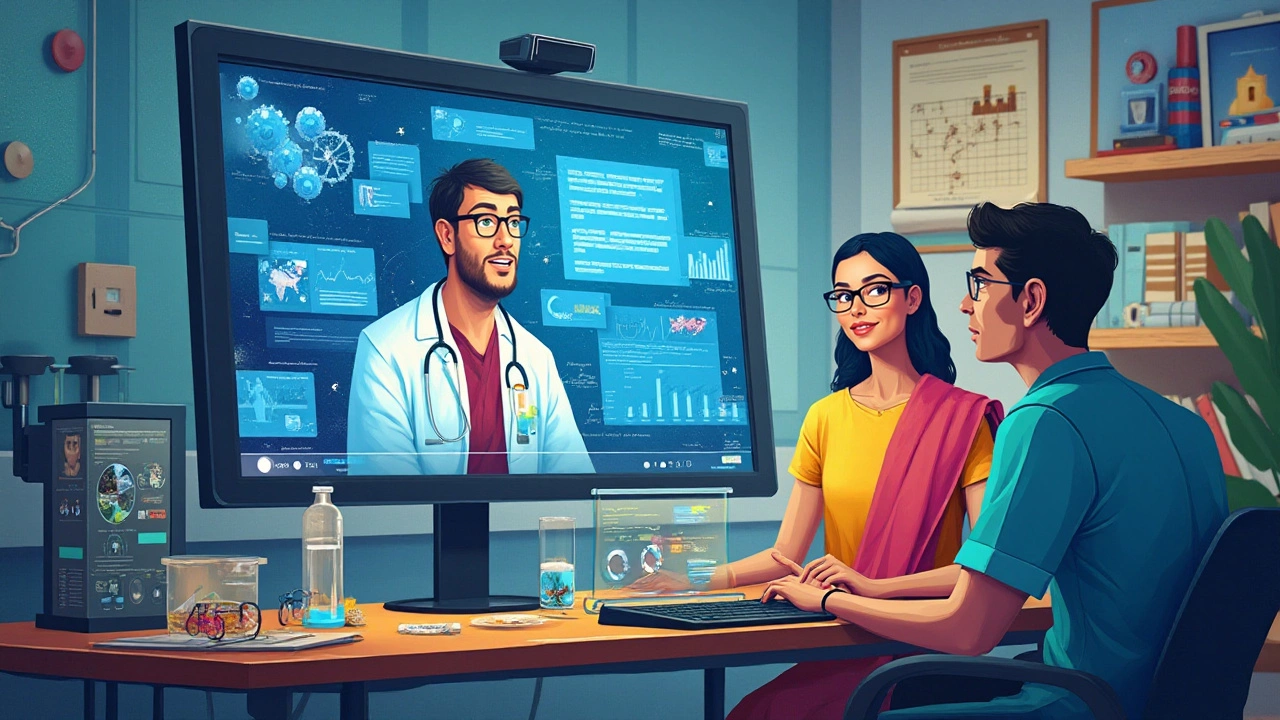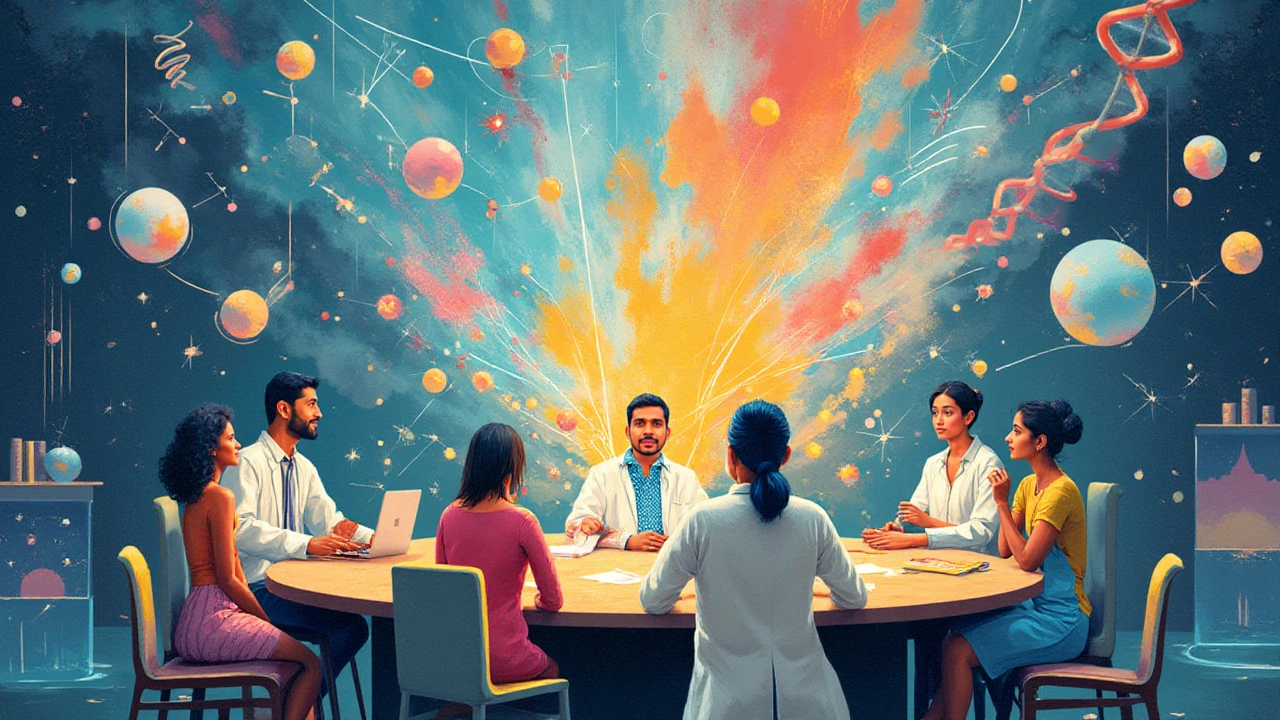In the world of science, innovation thrives not in isolation but through the symbiotic relationship between minds driven by curiosity and a shared purpose. Delving into the dynamics of scientific cooperation reveals not just an alliance, but a powerful engine of progress.
To truly grasp the impact of cooperative science, we must go beyond the lab coats and microscopes, witnessing how diverse talents come together to solve today’s most pressing issues. This cooperation forms the backbone of cutting-edge research and sparks the creative ideas that propel societal advancement.
In this exploratory journey, we find that the essence of collaboration is much like a well-choreographed dance: each step is carefully coordinated, yet leaves room for improvization and the unexpected serendipity of discovery.
- Understanding Cooperative Science
- The Building Blocks of Collaboration
- Success Stories in Scientific Cooperation
- Challenges and Solutions
- The Future of Collaborative Research
Understanding Cooperative Science
At its core, scientific cooperation transcends the simplistic notion of combined resources or shared data. It embodies a dynamic framework where multiple scientific disciplines intersect, leading to the cross-pollination of ideas and innovations.
Cooperation in science isn't merely a modern construct; it has roots that extend deep into history. Take, for instance, the collaboration between James Watson and Francis Crick in the discovery of the DNA double helix structure in 1953. Such groundbreaking achievements underscore the necessity of collaborative endeavors in scientific research.
A Framework for Interdisciplinary Collaboration
One of the largest driving forces behind collaboration is the increasing complexity of today’s research questions. Many societal challenges, such as climate change and infectious disease outbreaks, are too intricate for any single discipline to tackle alone. Cooperative projects often integrate knowledge from areas as diverse as biology, engineering, social sciences, and computer science.
Partnerships can exist on various levels, ranging from universities teaming up to international coalitions like the Human Genome Project, where institutions across continents united to map the entirety of human DNA. Such initiatives highlight how cooperative efforts amplify the scope and impact of research outcomes.
The Role of Technology in Facilitating Cooperation
In today’s digital age, technology has significantly bolstered scientific cooperation. Tools such as virtual labs, cloud computing, and collaborative platforms offer researchers the capability to work together irrespective of geographical constraints. This has paved the way for virtual collaborations and data sharing on an unprecedented scale.
A recent study illustrated that publications resulting from international collaborations are cited nearly twice as frequently as those from single-nation studies, demonstrating the enhanced visibility and impact of cooperative research.
Effective Communication: The Heart of Successful Collaboration
Communication is the cornerstone of successful collaboration. Without clear and consistent interaction, even the most promising partnerships can flounder. Understanding not only technical jargon but also the cultural nuances and expectations of partners plays a pivotal role.
Conclusion
Understanding cooperative science involves appreciating the intricate webs of interaction and the illustrious history of collaboration that boost the potential for groundbreaking discoveries. As we continue to forge partnerships across borders and disciplines, the promise of what can be achieved together remains one of science’s greatest assets.
The Building Blocks of Collaboration
At the heart of any successful scientific endeavor lies the practice of scientific cooperation. This form of collaboration isn't merely an aggregation of efforts but a strategic alignment of skills, objectives, and resources. When scientists from diverse domains converge, the outcome is often more comprehensive than any solitary pursuit.
The Role of Communication
Effective communication is the lifeblood of any collaborative venture. It ensures that ideas are clearly articulated and that any misinterpretations are swiftly addressed. Regular meetings, digital communication tools, and collaborative platforms like Slack or Microsoft Teams, facilitate this essential exchange. When team members can express ideas freely, the project benefits from a breadth of perspectives.
Shared Goals and Vision
Setting shared goals is crucial. Researchers must align their personal objectives with the collective aim of the study. When everyone is striving towards a common goal, it harnesses individual motivations and channels them toward a singular purpose, creating a cohesive network of contributors.
Diverse Expertise and Resource Allocation
The strength of a collaborative effort often lies in its diversity. By assembling a team with varied expertise, the collective knowledge base is enriched, fostering innovation. A physicist may bring a different perspective to addressing a problem than a biologist might, yet both contribute to a multidimensional understanding of the issue. Similarly, resources such as state-of-the-art laboratories, funding, and access to datasets are pooled together, optimizing the research process.
Technology and Tools
Advancements in technology have significantly enhanced collaboration within the scientific community. Shared databases, cloud computing, and AI-driven analytics allow researchers to share and analyze data seamlessly, transcending geographical barriers. Platforms like Google Scholar enable access to a vast amount of research, facilitating informed decision-making and hypothesis formulation.
Impact of Collaborative Research
Multiple studies have substantiated the impact of cooperative science, underscoring its importance in producing high-impact research. For instance, projects like the Human Genome Project, involving thousands of international collaborators, highlight the transformative potential of such alliances. This collective effort not only accelerated genomic research but also set a new standard for collaborative science.
In summary, the building blocks of collaboration in science involve more than just teamwork. They encompass effective communication, shared goals, leveraged expertise, unified resource allocation, and the intelligent deployment of technology. Together, these elements create a robust framework for scientific exploration and discovery.

Success Stories in Scientific Cooperation
The realm of scientific cooperation is punctuated by remarkable achievements that underscore the power of collective effort. These success stories not only highlight the ability of researchers to transcend borders but also demonstrate how collaborative ventures pave the way for groundbreaking discoveries.
Human Genome Project: Unraveling the Code of Life
Arguably one of the most ambitious scientific collaborations in modern history, the Human Genome Project brought together researchers from across the globe with a single mission: mapping the entire human genome. Initiated in 1990, this project involved the coordination of dozens of research centers and the pooling of international expertise, leading to the complete sequencing of human DNA in 2003. This monumental achievement has since revolutionized medicine, providing insights into genetic disorders and paving the way for personalized medicine.
CERN's Large Hadron Collider: Pushing the Boundaries of Physics
In the endeavor to unlock the universe’s deepest secrets, CERN’s Large Hadron Collider (LHC) stands as a testament to successful collaboration among thousands of scientists from over 100 countries. The discovery of the Higgs boson particle in 2012 was a watershed moment, confirming theories that form the bedrock of particle physics. The LHC continues to be an epicenter for scientific innovation, fostering partnerships that probe the fundamental laws of nature.
International Space Station: A Cosmic Partnership
The International Space Station (ISS) is another shining example of scientific cooperation, orbiting Earth as a symbol of peace and collaboration in space exploration. This joint venture, involving space agencies from the United States, Russia, Europe, Japan, and Canada, facilitates research across a spectrum of fields including biology, physics, and astronomy. The ISS’s role in both scientific discovery and diplomatic relations underscores how international teamwork can achieve what is beyond the capacity of any single nation.
Impact of International Alliances
These stories are not only awe-inspiring but also highlight the crucial role that teamwork and resource sharing play in scientific breakthroughs. The success of these projects demonstrates how pooling intellectual capital and technological resources can lead to more comprehensive, reliable, and impactful research outcomes.
As a testament to this, the global scientific community increasingly recognizes that addressing complex challenges such as climate change, pandemic responses, and sustainable development requires a cooperative approach. By embracing these alliances, the path is paved for advances that reshape our understanding and improve our world.
Challenges and Solutions
Navigating the landscape of scientific cooperation is akin to embarking on an expedition through uncharted territories, where the terrain presents a blend of barriers and opportunities. While cooperation is pivotal in steering groundbreaking research, the journey is not devoid of obstacles. Addressing these challenges strategically can transform them into stepping stones for success.
Communication Barriers
One of the primary hurdles is the communication gap, which often stems from differing scientific languages used across varied disciplines. This can lead to misunderstandings that hinder progress. Clear, consistent communication strategies are vital. Regular meetings, utilizing collaborative digital platforms, and fostering a culture of openness can mitigate miscommunications.
Resource Allocation
Resources, both financial and infrastructural, often impede collaborative research efforts. Institutions might have conflicting priorities, or funding bodies may impose restrictions that complicate shared endeavors. Establishing a unified funding framework with transparent guidelines helps streamline resource allocation, ensuring all partners are adequately supported.
Case Study: The Human Genome Project
The Human Genome Project exemplifies leveraging cooperative strategies to overcome resource-related challenges. By pooling resources from various international stakeholders, the project was completed ahead of schedule, underlining the efficacy of efficient resource management.
Cultural and Institutional Differences
Diverse cultural and institutional practices can also pose significant barriers. Different approaches to problem-solving and administrative processes need to be harmonized. Encouraging mutual respect and understanding and implementing standards can bridge these gaps, facilitating smoother cooperation.
Intellectual Property and Data Sharing
Protecting intellectual property while promoting open data exchange can be contentious. Scientists must navigate the fine balance between confidentiality and collaboration. Developing clear agreements that outline data sharing and ownership rights can provide clarity and protect interests, allowing for seamless data flow.
Potential Solutions
- Establishing clear communication protocols to minimize misunderstandings.
- Creating joint funding mechanisms to pool resources and optimize allocation.
- Training researchers on cultural competence to enhance multi-disciplinary synergy.
- Drafting comprehensive data-sharing agreements to safeguard intellectual assets while promoting transparency.
Structured problem-solving mechanisms and a commitment to flexibility and innovation form the backbone of successful scientific collaboration. With these strategies, the scientific community can forge ahead, transforming challenges into catalysts for groundbreaking discoveries.

The Future of Collaborative Research
As we gaze into the horizon of scientific cooperation, it becomes clear that the future holds exciting prospects filled with novel approaches and groundbreaking advancements. The rapid pace of technological advancement is reshaping how researchers collaborate, overcoming geographical boundaries and cultural differences.
Digital Transformation and Virtual Collaboration
With the advent of digital tools and platforms, collaboration isn't confined to the physical lab. Virtual labs and cloud-based research environments provide scientists globally with access to shared resources and the ability to work together in real-time. Scientists can now conduct experiments and analyze data collaboratively without ever meeting in person, accelerating the pace of discovery.
Cross-Disciplinary Integration
The merging of different scientific disciplines is creating a synergy that enhances problem-solving capabilities. Biologists working with computer scientists, or physicists teaming up with chemists, spawn innovative solutions to complex challenges. This cross-disciplinary approach is crucial in addressing grand issues like climate change or pandemic responses, where a holistic view is necessary.
Open Science Initiatives
Open science is paving the way for more inclusive, transparent, and accessible research. By sharing data openly and freely, research is not only reproducible but also allows for collective validation and improvement. Initiatives like the Open Science Network are gaining momentum, advocating for the democratization of scientific research.
AI and Machine Learning as Catalysts
Artificial intelligence and machine learning are transforming the landscape of scientific research. By processing enormous datasets efficiently, AI assists scientists in identifying patterns and predicting future trends, hence accelerating the research process. The integration of AI in research is like granting scientists an incredibly capable assistant, amplifying the impact of their collaborative efforts.
| Trend | Impact on Collaboration |
|---|---|
| Virtual Labs | 24/7 multi-geographical access to lab resources |
| Cross-Disciplinary Projects | Enhances innovative problem-solving |
| Open Science | Increases accessibility and transparency |
| AI Integration | Speeds up data analysis and discovery |
These technologies and methodologies are not just buzzwords; they represent the tangible future of research, where teamwork and collaboration are the linchpins of innovation. As we stand on the cusp of a new era, the key to unlocking the scientific potential of tomorrow lies in nurturing an environment where cooperation is not just encouraged but is the very foundation of scientific endeavor.





